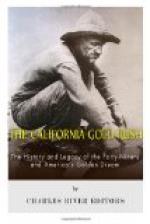The organization that was immediately perfected was complete and interesting. This was an association that was banded together and close-knit, and not merely a loose body of citizens. It had headquarters, company organizations, police, equipment, laws of its own, and a regular routine for handling the cases brought before it. Its police force was large and active. Had the Vigilance movement in California begun and ended with the Committee of 1851, it would be not only necessary but most interesting to follow its activities in detail. But, as it was only the forerunner and trail-blazer for the greater activities of 1856, we must save our space and attention for the latter. Suffice it to say that, with only nominal interference from the law, the first Committee hanged four people and banished a great many more for the good of their country. Fifty executions in the ordinary way would have had little effect on the excited populace of the time; but in the peculiar circumstances these four deaths accomplished a moral regeneration. This revival of public conscience could not last long, to be sure, but the worst criminals were, at least for the time being, cowed.
Spasmodic efforts toward coherence were made by the criminals, but these attempts all proved abortive. Inflammatory circulars and newspaper articles, small gatherings, hidden threats, were all freely indulged in. At one time a rescue of two prisoners was accomplished, but the Monumental bell called together a determined band of men who had no great difficulty in reclaiming their own. The Governor of the State, secretly in sympathy with the purposes of the Committee, was satisfied to issue a formal proclamation.
It must be repeated that, were it not for the later larger movement of 1856, this Vigilance Committee would merit more extended notice. It gave a lead, however, and a framework on which the Vigilance Committee of 1856 was built. It proved that the better citizens, if aroused, could take matters into their own hands. But the opposing forces of 1851 were very different from those of five years later. And the transition from the criminal of 1851 to the criminal of 1856 is the history of San Francisco between those two dates.




